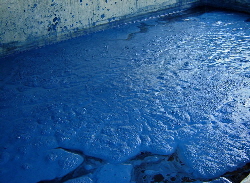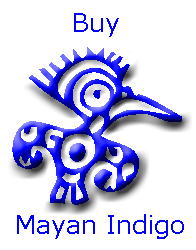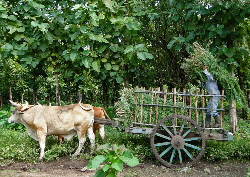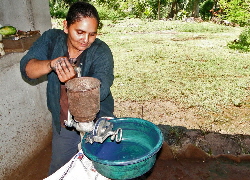|
 We sell indigo produced in El Salvador, which is the main indigo producer in Latin America. These indigo plants are grown on small farms that are committed to organic and fair trade production. The farms are reviving indigo cultivation that has been a traditional crop in that area since the 1800s. We sell indigo produced in El Salvador, which is the main indigo producer in Latin America. These indigo plants are grown on small farms that are committed to organic and fair trade production. The farms are reviving indigo cultivation that has been a traditional crop in that area since the 1800s.
You can help small-scale Salvadorian farmers by using our high quality indigo to dye beautiful blues. Mayan indigo has a high indigotin content (45%) making it easier for you to achieve dark blues.
- Cultivation of Mayan Indigo in El Salvador
- Harvesting Mayan Indigo
- Fermenting the Indigo
- Oxygenating the Indigo Vat
- Sedimenting and Filtering the Indigo Pigment
- Drying the Indigo pigment
- Grinding the Indigo pigment
 Indigo Production in El Salvador Indigo Production in El Salvador
1) Cultivation of Mayan Indigo in El Salvador
Indigo grows well in the seasonally dry volcanic soil of El Salvador. Like all legumes (the bean family), indigo has nitrogen-fixing bacteria in the roots enhancing the soil fertility, so there is no need for chemical fertilizers on the indigo crop. The species grown is Indigofera tinctoria.
2) Harvesting Mayan Indigo
 In El Salvador, all harvesting is done by hand, employing local workers, and the leaves are transported to the processing tanks by oxcart, a traditional, low-environmental impact system. In El Salvador, all harvesting is done by hand, employing local workers, and the leaves are transported to the processing tanks by oxcart, a traditional, low-environmental impact system.
3) Fermenting the Indigo
The leaves and branches of the indigo plants are piled into a concrete tank with fresh well water. Workers then tread barefoot on the leaves to macerate them and the leaves are left to rest and ferment for 12 hours. When the water has been drained, the residue is greenish blue. For more information on the chemistry behind this process see indigo chemistry.
4) Oxygenating the Indigo Vat
A pump is used to agitate the water in the indigo vat and introduce air until blue foam appears on the top and the indigo pigment starts to form. The blue water in the vat is then left to rest for a day.
5) Sedimenting and Filtering the Indigo pigment
|

|
|
Grinding the caked indigo pigment to indigo dye
|
|
The indigo pigment slowly settles to the bottom of the tank. Most of the water is siphoned out and the wet pigment is then placed on cotton cloth to filter out the remaining water.
6) Drying the Indigo pigment
The indigo paste is spread out onto tins and dried in the sun until it solidifies and shrinks, creating a beautiful crackle pattern. No fossil fuels are used to dry the indigo.
7) Grinding the Indigo pigment
Finally, the pigment is ground by hand into the fine Mayan Indigo powder that you buy from Wild Colours.
Top of page
|